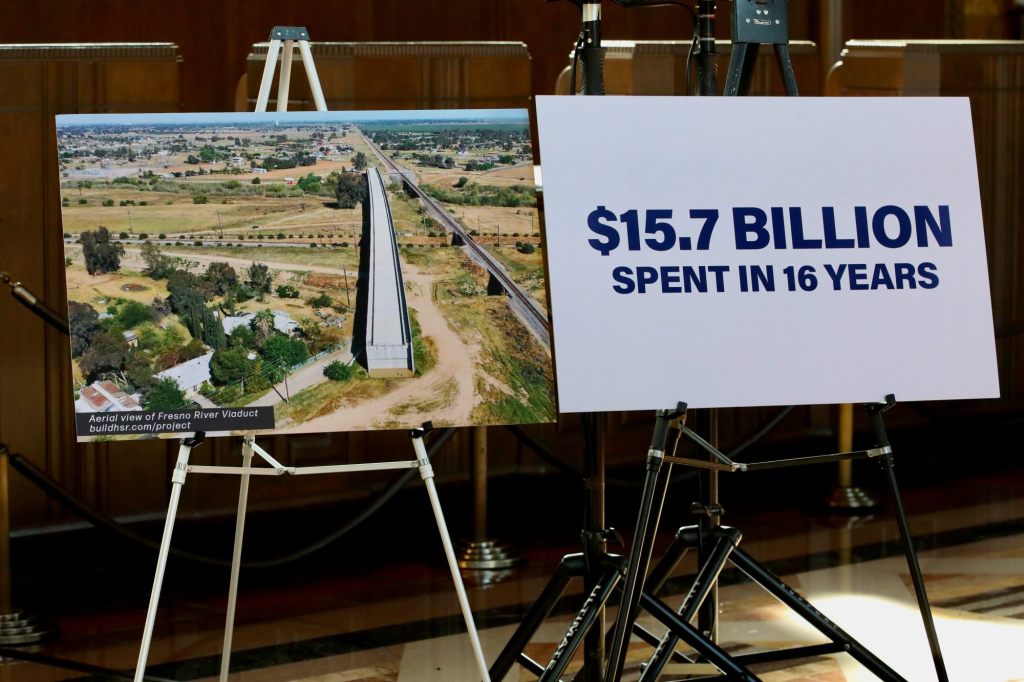
President Trump’s recent decision to terminate $4 billion in unspent federal funding for California’s high-speed rail project is more than a policy shift, it’s a long-overdue act of accountability for taxpayers. For years, this project has been a case study in government mismanagement, with billions spent, no track laid, and no end in sight.
The high-speed rail project began with big promises and public support. In 2008, California voters narrowly approved Proposition 1A, authorizing $9.95 billion in bonds to fund a clean, efficient rail line from San Francisco to Los Angeles, with an estimated total cost of just $33 billion and a target completion date of 2020. Taxpayers were told the project would be fast, on time, and self-sustaining.
Instead, it has become a slow-moving disaster.
After nearly two decades and over $15 billion in spending, the California High-Speed Rail Authority (CHSRA) has failed to lay a single mile of operable high-speed rail. Costs have quadrupled, timelines have collapsed, and the original vision has been abandoned. The project is now limited to a 119-mile segment in the Central Valley, with no direct connection to the Bay Area or Southern California, a projected cost of $128 to $135 billion and a hypothetical completion no earlier than 2033.
In the 1930s, we built the Hoover Dam in under five years, and the Golden Gate Bridge in just four years. The stark difference can be attributed to the bloat of bureaucracy. What happened?
Today’s project is a far cry from what California voters approved in 2008, and the legislature’s role cannot be ignored. Sacramento quietly authorized billions in spending without going back to voters, expanding project estimates and tapping into cap-and-trade revenues up to $1.25 billion annually. Even worse, Sacramento passed Senate Bill 198 in 2022 to create an Inspector General’s office, effectively admitting that there was a serious oversight problem but refusing to pull the plug. This runaway train to nowhere is powered by legislative approval, not taxpayer mandate.
In 2024, I introduced the No Frankenrail Act (H.R. 9308), which would prohibit further federal dollars going to projects with no meaningful progress despite years of investment. I called it “Frankenrail” because that’s exactly what California’s failed high-speed rail dream has become: a stitched-together monstrosity of broken promises, budget overruns, and bureaucratic bloat. This bill, along with Congressman Kevin Kiley’s subsequent H.R. 213 (2025) to prohibit the use of Federal financial assistance for California’s high-speed rail, set the stage before President Trump’s decisive order to formally rescind federal funding from the long-delayed and over-budget rail project.
California has spent roughly $10.5 billion in state funds and accepted another $3.9 billion from Washington—more than $14 billion down the tracks, and not a single passenger served. California taxpayers have already paid nearly $1,200 per household for a train that doesn’t exist. If the project continues to its projected completion, that figure could potentially reach $10,000 per household.
Meanwhile, a commercial flight from San Francisco to Los Angeles takes under an hour and typically costs less than the projected ticket price for the rail line. As the United States Secretary of Transportation, Sean Duffy, noted while pulling the plug on federal funding for the high-speed rail, we could have given 200 flights to each Los Angeles and San Francisco resident for the cost of this failed project. The state’s resources are better spent repairing and modernizing transportation infrastructure that we already have in place—airports, highways, and regional commuter systems which can be updated for a fraction of the cost.
Sacramento should follow Washington’s lead and cut off this project once and for all.
Unfortunately, Governor Gavin Newsom had decided to double down on his failure by directing the CHSRA to sue the Trump administration over the funding cut. Rather than accept responsibility for a two-decade failure, our governor is playing the victim, hoping he can force American taxpayers to bankroll a project that has produced no operable rail.
It’s not just tone deaf, it’s offensive—less a transportation project and more a political vanity project.
Sacramento refuses to let go because this is a gold mine for entrenched special interests. Billions in taxpayer dollars have flowed to politically connected contractors, labor unions, and consultants with little to show for it. The high-speed rail project has become a permanent stimulus for the politically favored, not a serious infrastructure solution.
California’s high-speed rail has become a monument to everything wrong with one-party rule in Sacramento. It demonstrates limitless ambition, no oversight, and total disregard for fiscal reality. Taxpayers deserve better. Californians deserve better. And it’s time for Sacramento to acknowledge what everyone else already sees: this train isn’t going anywhere.
Mike Garcia is a first-generation American, decorated Navy combat veteran, and former congressman who represented California’s 27th District. A former F/A-18 Super Hornet pilot and defense industry executive, he now serves as Chair of America First California at the America First Policy Institute.



